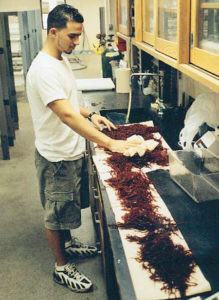
Use of ozone in seafood processing
Ozone is a universal disinfectant that can oxidize many inorganic and organic impurities, and destroy bacteria, viruses and other pathogens.
Some ciliated protozoa (ciliates) may be a valuable complimentary source of nutrients for first feeding larval stages of farmed shrimp.

Ozone is a universal disinfectant that can oxidize many inorganic and organic impurities, and destroy bacteria, viruses and other pathogens.

Over the last 15 years, seaweed farming in Chile reached a volume of over 300,000 metric tons per year, half brown algae and half red algae.

Abandoned mine sites are a significantly underused aquaculture resource in rural West Virginia and the Appalachian region.

Successful mass culture of the marine rotifers Brachionus plicatilis and B. rotundiformis is one of the milestones of marine fish culture.

L. vannamei can be raised at high densities and zero water exchange with acceptable survival, growth and yields while minimizing water-borne diseases.

High density fish aggregations represent new farming challenges regarding water quality and food distribution.

Since severe lymphoid organ necrosis can also appear as a result of WSSV infection, do not use this type of lesion as the sole feature to diagnose YHV.

Essentially, a substrate provides a high amount of a surface area that is readily colonized by bacteria and benthic algae, which behave as a huge biofilter.

The marine snail opisthobranch, a.k.a. the sea hare, is used for biomedical research in neuroscience as a model for memory and learning.

Low dissolved oxygen is associated with stressful conditions for shrimp. Liquid oxygen injection systems are a potential solution.

Most shrimp cultured today are fed diets with greater than 30 percent protein, with much of this protein obtained from fishmeal.

Australia’s prawn industry has encountered its first scare over white spot syndrome virus (WSSV) following positive test results in the northern territories.

Phospholipids and cholesterol are essential lipids for shrimp yet knowledge of dietary requirements during the juvenile stage is still limited.

Aerated microbial reuse systems recycle nutrients in the form of organic detritus, which consists of aggregates of organic particles coated with a film of bacteria.

Several studies now suggest the color of indoor aquaculture tanks should also be considered for improved animal health and performance in indoor systems.